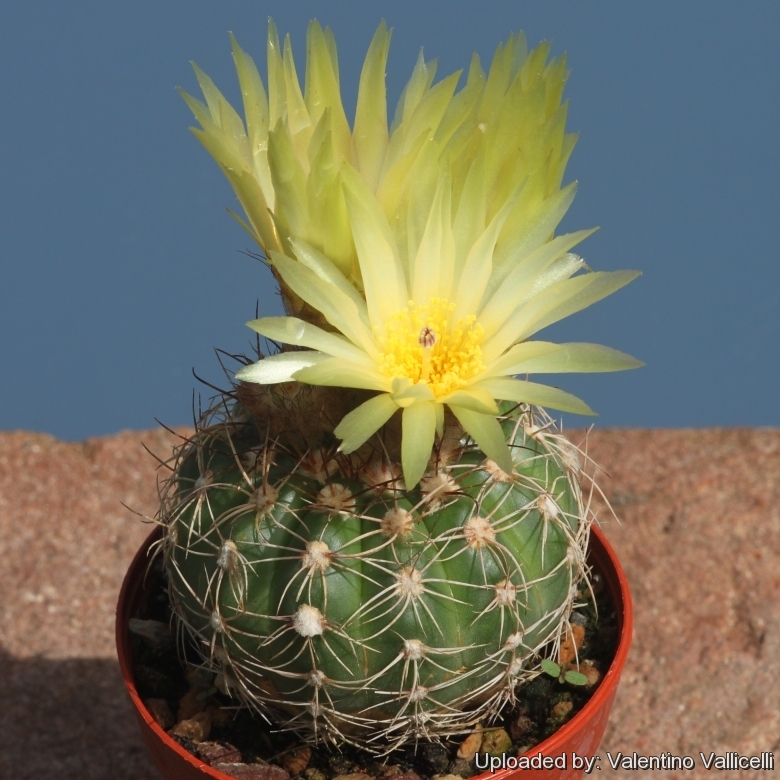Accepted Scientific Name: Parodia werneri Hofacker
Cactaceae Consensus Init. 6: 12, nom. nov. 1998 [replaced synonym: Notocactus uebelmannianus Buining]

Parodia arachnitis Photo by: Valentino Vallicelli
Origin and Habitat: Brazil, Rio Grande do Sul, Serra do Herval
Synonyms:
See all synonyms of Parodia werneri
back
Accepted name in llifle Database:Parodia werneri HofackerCactaceae Consensus Init. 6: 12, nom. nov. 1998 [replaced synonym: Notocactus uebelmannianus Buining]Synonymy: 24
back
Description: Parodia arachnitisSN|25131]]SN|20010]] (Notocactus) ( = Parodia werneriSN|19997]]SN|19997]] accepted scientific name) is usually a solitary cactus that sometime forms multi-headed clumps. It is a very close ally of Parodia crassigibbaSN|20010]]SN|25131]].
Stem: Simple, depressed-spherical up to 12 cm tall and 17 cm in diameter, dark green: ribs very low, rounded, with broad chin-like tubercles between the areoles.
Areoles: Whitish.
Radial spines: 10-14 varable more or less addpressed or slightly projecting, unequal in length, approximatively 5-30 mm long, mostly curved, whitish, yellow-white, grey or pale brown
Central spines: Usually absent or one.
Flowers: Rather variable in size, funnel-shaped, form and colour approx 3,7 cm long, white-yellow to sulphur-yellow (or reddish pink). The corolla tube is covered with wool-white to pale brown bristles.
Flowers: Spring-summer.
Fruit: Barrel-shaped, redish, 0,5-1,5 cm long.
Seeds: Cap-shaped, black to 1,4 x 1,4 mm. Hilum corky, seed-coat minutely roughened under a lens.
Subspecies, varieties, forms and cultivars of plants belonging to the Parodia werneri group
Bibliography: Major references and further lectures
1) Curt Backeberg “Cactus Lexicon” Sterling Publishing Company, Incorporated, 1978Edward
2) F. Anderson (2001) “ The Cactus Family”.
3) Hiroshi Hirao “Colour encyclopaedia of cacti” Japan 1979 (Japanese language and script)
4) Willy Cullmann, Erich Götz (Dozent Dr.), Gerhard Gröner “The encyclopedia of cacti” Portland, OR: Timber Press, 1986
5) David Hunt, Nigel Taylor “The New Cactus Lexicon” DH Books, 2006 ISBN 0953813444, 9780953813445
6) Edward F. Anderson: “Das Grosse Kakteen-Lexikon.” Eugen Ulmer KG, 2005 (übersetzt von Urs Eggli), ISBN 3-8001-4573-1
7) Hans Hecht “BLV-Handbuch der Kakteen” BLV, 1991 (German language and script)
 Parodia arachnitis Photo by: Valentino Vallicelli
Parodia arachnitis Photo by: Valentino Vallicelli Parodia arachnitis Photo by: Valentino Vallicelli
Parodia arachnitis Photo by: Valentino Vallicelli Parodia arachnitis Photo by: Valentino Vallicelli
Parodia arachnitis Photo by: Valentino VallicelliSend a photo of this plant.The gallery now contains thousands of pictures, however it is possible to do even more. We are, of course, seeking photos of species not yet shown in the gallery but not only that, we are also looking for better pictures than those already present.
Read More... Cultivation and Propagation: Notocactus arachnites is an easy to grow tropical notocactus, more cold tolerant than most and less fussy regarding soil conditions.
Growth rate: It is a relatively rapidly growing and easily flowering species that will make clumps given the best conditions.
Soils: It likes very porous standard cactus mix soil.
Repotting: Use pot with good drainage.
Watering: Water regularly in summer, but do not overwater (Rot prone), keep dry in winter.
Fertilization: Feed with a high potassium fertilizer in summer.
Hardiness: Reputedly sensitive to frost, but less so if kept on the dry side prior to, and during, cold weather (hardy to -5° C for short periods). However warmth throughout the year will increase the grower's success (8-12°C during rest season).
Exposition: Outside bright but partially filtered sunlight or afternoon shade, inside it needs bright light, and some direct sun. Subject to sunburn if exposed to direct sun for too long. Tends to bronze in strong light, which encourages flowering and heavy wool and spine production.
Uses: It is an excellent plant for container growing. It always looks good and stays small. It look fine in a cold greenhouse and frame or outdoor in a rockery.
Pests & diseases: It may be attractive to a variety of insects, but plants in good condition should be nearly pest-free, particularly if they are grown in a mineral potting-mix, with good exposure and ventilation. Nonetheless, there are several pests to watch for:
- Red spiders: Red spiders may be effectively rubbed up by watering the plants from above.
- Mealy bugs: Mealy bugs occasionally develop aerial into the new growth among the wool with disfiguring results, but the worst types develop underground on the roots and are invisible except by their effects.
- Scales: Scales are rarely a problem.
- Rot: Rot is only a minor problem with cacti if the plants are watered and “aired” correctly. If they are not, fungicides won't help all that much.
Propagation: Division, direct sow after last frost. Seeds germinate in 7-14 days at 21-27° C in spring, remove the glass cover gradually as the plants develops and keep ventilated, no full sun for young plants! To make a cutting twist off a branch and permit it to dry out a couple of weeks, lay it on the soil and insert the stem end partially into the soil. Try to keep the cutting somewhat upright so that the roots are able to grow downward.













